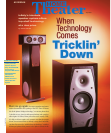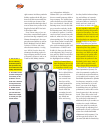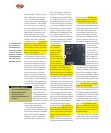
which includes a test CD, an SPL
meter calibrated for low frequen-
cies, a measurement template,
and a frequency-curve tool Infinity
calls the “Q finder”—all of which
are used to plot your room’s fre-
quency response and make the
necessary adjustments. You can
either do the calculations your-
self or input your data on the
R.A.B.O.S. Online page of Infinity’s
Website, where they will do the
computations for you. As I said in
the Prelude review, R.A.B.O.S.’s
slick factor is superceded only by
its effectiveness. Once again, this
kind of technology in an entry-level
line is a serious perk.
There are multiple models of
each speaker type (front, center,
surround) in the Interlude line. For
this review, I went for the least
expensive of each: the IL50 pow-
ered towers ($1,800/pair), the
IL25c center channel ($300), and
the IL10 surrounds ($400/pair),
each of which uses C.M.M.D.
drivers from top to bottom. The
IL50 is a powered tower that has a
1-inch tweeter, a 6.5-inch midbass,
a 10-inch sub, a 250-watt internal
sub amp, and the aforementioned
R.A.B.O.S. with
controls at the rear.
The back panel also
sports a line-level
sub input and output,
speaker-level inputs,
and a fixed low-pass-
filter switch. A main
level control for the sub is found
on the front of the speaker.
The horizontally aligned IL25c
has dual 5.25-inch midbass drivers
and a 1-inch tweeter in a D’Appolito
array, while the direct-
radiating
IL10 has a single 6.5-in
ch mid-
bass driver and a 1-inch tweeter.
The IL50 measures 42 inches
high by 8.75 wide by 14.5 deep
and weighs 60 pounds; the IL25c
is 7.5 high by 20.5 wide by 7.5 deep
and weighs 20 pounds; and the
IL10 is 15.625 high by 8.5 wide by
11.5 deep and weighs 18 pounds.
Each model’s beveled front baf-
fles are constructed of 1.5-inch
MDF and are available with a nat-
ural maple, natural cherry, or
onyx anigre vinyl finish. All of the
drivers are magnetically shielded,
and the grilles are available in a
variety of colors.
First, I tested
the Interludes
with two-channel
material, and I
found that the
IL50s performed
much as I expected
they would with
music—quick and
tight in the midrange, accurate
throughout, and forgiving of
harsher material on the top end
without sounding soft or laid-back.
Good drivers can do good things,
no matter what the speaker costs.
Out of the box, the bass was big
and boomy—far too boomy for my
taste—but there’s plenty here for
those who like their walls to rattle.
I quickly adjusted the main level
control on the front baffle and then
had a colleague adjust the equal-
izer’s level and frequency controls
while I sat in the listening position.
The effect was considerable. The
subs tightened right up without
sacrificing much in the way of
punch or impact. The transition
from sub to midrange was also rel-
atively smooth, something that’s
never a given with any full-range
speaker, especially a powered
tower. Obviously, I can’t tell you
that the IL50s were as spectacular
from top to bottom as the Preludes,
but I can tell you that these are
easily among the best speakers
I’ve heard in this price range.
The IL10s and IL25c joined the
IL50s for the multichannel-music
demo, which began with the Sony
SCD-CE775 SACD player that I
had recently acquired (see the
review in this issue). Granted,
SACD is an outstanding medium;
however, formats, sources, et al,
can’t make bad speakers sound
good—they simply
unveil what a
system is capable
of. The SACD
demo spoke vol-
umes about what
these speakers
can do. The fact
that I could hear
the differences in
the SACD material clearly proved
that this system is significantly
detailed, revealing, and (as I men-
tioned before) highly accurate.
My ears told me initially—and the
measurements later confirmed—
that you’ll be hard-pressed to find
more-accurate speakers at this
price. The IL10 is a musical little
bugger in its own right, so those
of you who may write this speaker
off as a surround because it’s not
bi-/dipolar shouldn’t. What little
compromise the IL10s make with
soundtracks, they make up for
tenfold with music (where direct-
radiators hold a significant advan-
tage), and they’d make a great
little stereo pair for the bedroom,
kitchen, etc. You don’t run across
drivers this good very often in a
bookshelf model.
The Interludes were not quite
as impressive with soundtracks as
they were with music, but I’d still
D. The IL50’s back
panel offers the
standard array of
subwoofer controls,
as well as the level,
frequency, and band-
width adjustments
that make up the
R.A.B.O.S. system.
D
• Top-quality C.M.M.D. drivers
• Highly effective room-
correction system
• Excellent performance for
the price
HIGHLIGHTS






